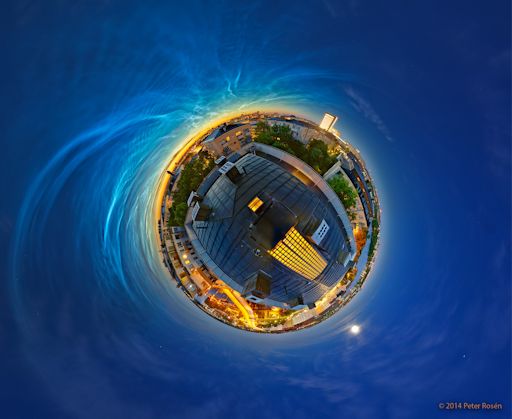Daily Suspicious0bserver's Weather Post:
July 13, 2014
What's in the sky tonight?
July 13, 2014
-This is the evening when Mars shines closest to Spica. Look southwest at nightfall. They're 1.3░ apart. Fiery Mars is the brighter one.
-Last night another outbreak of noctilucent clouds appeared over Europe. Photographer Peter RosÚn of Stockholm, Sweden, stitched together 24 exposures taken with a fisheye lens to produce a "Little Planet" projection. "The NLC display last night was just incredible and covered half of the sky with electric blue filaments," says Rosen. "Normaly the Moon would have stolen the show, but a night like this it looked quite lonely on the southern horizon."
NLCs are Earth's highest clouds. Seeded by "meteor smoke," they form at the edge of space 83 km above Earth's surface. When sunlight hits the tiny ice crystals that make up these clouds, they glow electric blue.
In the northern hemisphere, July is the best month to see them. NLCs appear during summer because that is when water molecules are wafted up from the lower atmosphere to mix with the meteor smoke. That is also, ironically, when the upper atmosphere is coldest, allowing the ice crystals of NLCs to form.
The natural habitat of noctilucent clouds is the Arctic Circle. In recent years, however, they have spread to lower latitudes with sightings as far south as Utah and Colorado. This will likely happen in 2014 as well.
 Astro Picture of the Day:
July 13, 2014
Source:
Astro Picture of the Day:
July 13, 2014
Source:
NGC 2818 is a beautiful planetary nebula, the gaseous shroud of a dying sun-like star. It could well offer a glimpse of the future that awaits our own Sun after spending another 5 billion years or so steadily using up hydrogen at its core, and then finally helium, as fuel for nuclear fusion. Curiously, NGC 2818 seems to lie within an open star cluster, NGC 2818A, that is some 10,000 light-years distant toward the southern constellation Pyxis (the Compass). At the distance of the star cluster, the nebula would be about 4 light-years across. But accurate velocity measurements show that the nebula's own velocity is very different from the cluster's member stars. The result is strong evidence that NGC 2818 is only by chance found along the line of sight to the star cluster and so may not share the cluster's distance or age. The Hubble image is a composite of exposures through narrow-band filters, presenting emission from nitrogen, hydrogen, and oxygen atoms in the nebula as red, green, and blue hues.